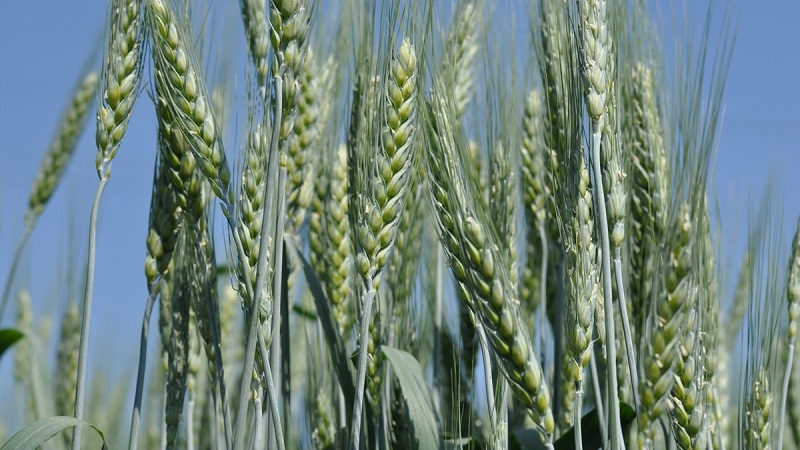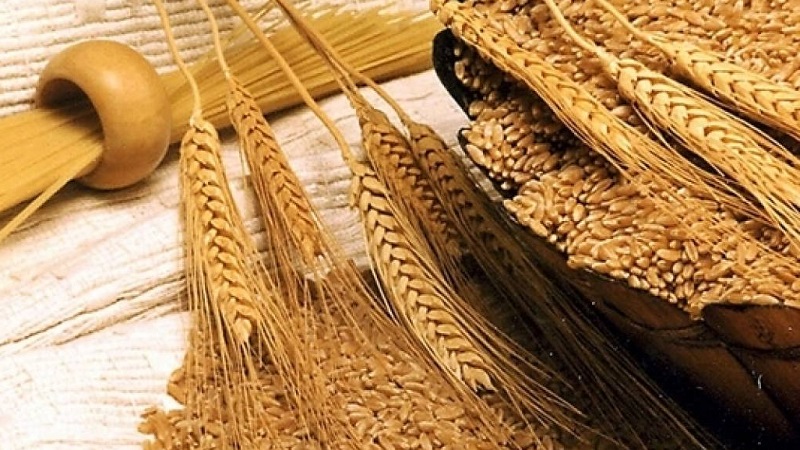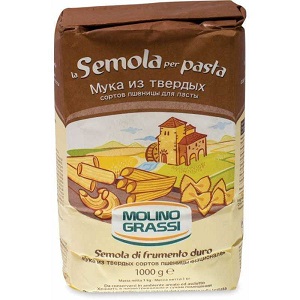What are the features of durum wheat flour, how to choose and use it
Many people know that durum wheat flour is ideal for baking and making homemade pasta. But not everyone knows why this is so, what properties such flour has, what technology it is produced by and how to use it correctly. Detailed answers to these questions are in our article.
The content of the article
What is this flour, what are its features
Wheat is one of the most common grains on the planet... There are more than a thousand varieties of this culture. They are conventionally divided into soft and hard.
For soft varieties a humid climate is suitable, therefore they are grown in Australia, Western Europe and most of the CIS countries. Hard varieties grow best in dry continental climates, so most of the harvest is obtained in Canada, Argentina, USA, African and Asian countries.
Durum wheat makes up only 10% of the total world cereal production, although it is popular in many countries.

Properties
Durum wheat flour is primarily used for the production of pasta and pasta... The finished products are tasty and, most importantly, healthy.
Important! Contrary to popular belief, durum wheat pasta does not get fat. The Italians are a prime example. Their cuisine is based on various types of pasta, but most of the inhabitants of this Mediterranean country are slim.
The benefits of durum wheat flour products are explained by the properties of the grain:
- Unlike ordinary soft wheat, the main component of which is starch, in durum cereals contains a lot of gluten and protein.
- The main component of pasta or durum wheat pasta is complex carbohydrates... They have a low glycemic index, so they do not stimulate insulin production and do not lead to weight gain.
- In flour made from such wheat, contains a lot of vitamin B1which prevents the development of cancer and strengthens the cardiovascular system.
Specifications
Hard grain flour is divided into two types: whole grain (semola integrale) and from refined raw materials (semola).
Reference! Each species is divided into several types. They differ from each other in color and degree of grinding (size of fraction).
The main characteristics of any flour, including from durum wheat, are considered:
- The nutritional value... When milled, the germ and endosperm of the grain turns into flour, and the shell is used in the production of bran. It is noteworthy that the lower the grade of flour, the higher the concentration of nutrients and vitamins in it.
- Chemical composition... Determined by the content of proteins and carbohydrates. Durum products are high in gluten and protein, while complex carbohydrates provide long-term satiety.
- General characteristics... These include the taste, color and smell of the product. High-quality flour should be light, without foreign taste or smell.
Ash content is considered an important criterion for evaluating flour from durum wheat.... This indicator is determined by the amount of minerals. They are not contained in the embryo, but in the shell of the grain. Therefore, the higher the ash content, the lower the flour quality according to the generally accepted classification.

Grinding technology
The technology of grinding durum wheat grains differs from the similar production process for soft varieties.... The primary product of processing is grits. So that there are no third-party inclusions in it, they thoroughly clean and grind the grains.
Reference! The hardest wheat variety is durum. It is rich in gluten and protein, and the resulting flour has a high density and is used in Mediterranean cuisine for baking bread.
Grain processing takes place in several stages:
- The grain is cleaned, treated with cold and hot water. To obtain the raw material of the required type, at this stage, mixing of several varieties is allowed.
- Further carry out geothermal treatment... The raw material is moistened and heat treated. This removes excess moisture and increases the elasticity of the casing.
- At the conditioning stage remove the outer layers of grains... Due to this, the membranes are easily separated from the endosperm.
- Part of the grain mass checked in the laboratory to determine the amount of impurities, wet gluten and moisture levels.
For the manufacture of flour of a specific type, different grinding parties are used.... The process consists of crushing and screening. During the first one, roller machines are used, the type of which determines the shape of the fraction of the final product.
Sifting is the final stage, during which the finished product is finally purified from foreign impurities.
Benefit and harm
Durum wheat flour is considered the healthiest... It contains a lot of gluten and protein, complex carbohydrates and fats. Durum wheat products increase weight gain and do not increase blood glucose levels.
In addition, it contains such components:
- Vitamin B - eliminates stress and headache.
- E - antioxidant, reduces the effects of harmful radicals.
- AND - strengthens the immune system, increases resistance to infections.
- RR - helps the body produce energy.
- FROM - increases the body's resistance and effectively fights against vitamin deficiency.
This type of flour contains essential minerals for the human body. - calcium, potassium, phosphorus, manganese, sodium, etc.

There is no harm from eating durum wheat flour... Since it contains only unsaturated fats, pasta and pasta do not lead to weight gain. This product is recommended for diabetics and overweight people.
Interesting on the site:
Types of durum wheat flour
The best durum wheat flour is considered to be Italian... In this country, it is most often used, as the basis of the local cuisine is pasta and pasta. Since the benefits of this product have been scientifically proven, the production of high-quality flour from hard grain began in our country.
In the CIS countries
In the CIS countries, flour is more often produced from soft wheat varieties... The hard ones are not that popular, but they do exist:
- Durum - the variety with the hardest grains and the highest protein concentration (15%). It contains a lot of carotenoid pigment, which gives the pasta a pleasant golden color.
- Triticale - a hybrid crop obtained by crossing wheat with rye. Suitable for cultivation in the climatic conditions of our country, as it is characterized by increased productivity and winter hardiness.
Despite the fact that hard varieties are beginning to gain popularity among farmers, most fields in the CIS countries are still sown with soft wheat.
In Italy
Durum wheat flour is the main component of many Italian dishes... Not only pasta and pasta are made from it, but also bread is baked and cereals and desserts are prepared.
The type of Italian flour depends on the degree of grinding:
- In the process of grinding grains get semola. It is fine-grained, similar in structure to sand and has a yellowish color.
- Secondary grinding is practiced in the southern regions of Italyresulting in semola rimacinata. It makes delicious bread with a special crumb texture. Such baked goods are perfectly stored and do not grow moldy for a long time.
- Flour spelled - a special variety... This is the oldest flour variety that is actively used in modern cooking. It is used to prepare pasta and pasta, dough for bread and sweet pastries, and is also used as a thickener for sauces.
How to use this flour correctly
Traditionally, durum wheat flour is used for homemade pasta and pasta production. But depending on the degree of grinding, it is suitable for baking bread, pies and other products.
Flour is a popular thickener for sauces... A striking example is Bechamel, which is used in the preparation of lasagna. Given the high concentration of nutrients and the absence of harm to the body, such a product can be safely included in the diet menu or diet for diabetics.
How to choose
To choose a quality product, pay attention to several criteria:
 Colour... Each variety has its own shade, but a slight yellowness is characteristic for solid ones. If the flour is diluted with water, its color should not change. If red or blue blotches appear, it is better to refuse the purchase.
Colour... Each variety has its own shade, but a slight yellowness is characteristic for solid ones. If the flour is diluted with water, its color should not change. If red or blue blotches appear, it is better to refuse the purchase.- Smell... Good quality flour is odorless. If you smell musty or other foreign matter, this means that the product has been stored incorrectly or for too long, and it is better not to eat it.
- Taste... The fresh product has a pleasant, even slightly sweet taste. Slight bitterness may appear after long-term storage.
If flour is sold in a package, carefully examine the package... It must be intact, with information about the composition, weight, terms and conditions of storage.
Top manufacturers
Ideally, buy Italian flour for homemade pasta.... Its packaging must bear the name Semola or Semolina.
In Russia, the most famous producer of this kind of flour is Makfabut there are other lesser known brands as well. Therefore, if you need to choose exactly products from hard varieties, be sure to study the packaging.
How to store
Flour should not be stored longer than 3 months.... After this period, it becomes denser and takes on an unpleasant musty smell.
If the room maintains a stable room temperature, the product will retain its nutritional properties for six months... At elevated temperatures, insects will settle in the flour or mold will appear. To protect the product from pests, put a few cloves of garlic inside the pack, and a bay leaf to protect it from high humidity.
Conclusion
Durum wheat is grown only in certain climates, and the flour obtained from them is especially useful for the body. It has little starch and a lot of gluten, so homemade pasta made with it leads to long-term satiety without gaining weight.